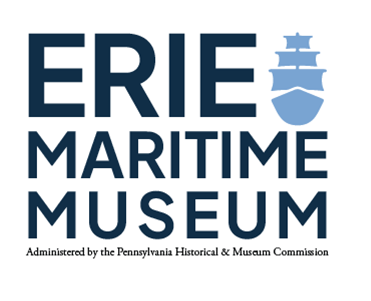U.S. Brig Niagara
Flagship of the Commonwealth of Pennsylvania
The U.S. Brig Niagara, home-ported at the Erie Maritime Museum, is a faithful reconstruction of Oliver Hazard Perry’s relief flagship during the Battle of Lake Erie. The Erie Maritime Museum and U.S. Brig Niagara are owned and administered by the Pennsylvania Historical and Museum Commission.
The months following the victory at Put-in-Bay were not kind to members of the American squadron at Presque Isle Bay. The jubilation following the American triumph at the Battle of Lake Erie quickly dissipated, giving way to internal discord and diminished morale fueled by the controversy surrounding Elliott's perceived inaction during the battle. Consequently, Perry, having secured a transfer from the Great Lakes, relinquished his command on October 25th, handing over control of the Lake Erie squadron to Elliott. Perry's journey back to Newport, Rhode Island extended over three weeks, marked by exuberant receptions, gifts, and banquets at each stop, a stark contrast to the unsettling situation he departed from.
In the wake of Perry's departure, distressing events unfolded. The British seized Fort Niagara and ravaged settlements at Buffalo and Black Rock, resulting in the loss of vital American vessels—specifically, the Little Belt, Chipaway, and the Sloop Trippe. Elliott urgently appealed to the Secretary of the Navy in January 1814, requesting 2,000 militia reinforcements at Erie to avert a surprise attack similar to the devastation at Buffalo.
Amidst these tensions, the British strategized to recapture lost vessels from Put-In-Bay and establish a new shipyard on the Lakes. Fortunately, the mild winter of 1814 prevented extensive ice coverage, thwarting a British incursion across the lake. Chauncey instructed Elliott to ready the Niagara and Lawrence to venture into Lake Huron as soon as ice conditions allowed, aiming to diminish the enemy's presence. Shortly after this directive, Elliott sought leave from Erie, prompting the Navy to dispatch Captain Arthur Sinclair to assume command.
Upon Sinclair's arrival, he described the Erie situation as dire. The winter of 1813-14 inflicted hardship on the naval station, with vessels requiring repairs and being far from ready for service. Morale plummeted as diseases like pneumonia and smallpox took a heavy toll, earning the anchorage the enduring name of "Misery Bay."
Sinclair encountered a disarrayed scenario with few capable officers, uncontrolled expenses, rampant crime leading to multiple arrests, and vessels left behind at Put-In-Bay requiring immediate repair. He initiated efforts to restore order, starting with recalling the abandoned prize ships to Erie for repairs and protection against British recapture, focusing on preparing for the upcoming season.
Commodore Arthur Sinclair
Image Courtesy of Peter Rindlisbacher, Misery Bay, 1814
Working tirelessly with limited supplies, Sinclair acted on intelligence about substantial flour and grain stores in Port Dover, Ontario, and orchestrated a joint strike on the mills. American troops, led by Colonel John Campbell, landed at Port Dover on May 14th, resulting in the destruction of several buildings, viewed as retribution for the British attack on Buffalo. This raid later served as partial justification for British assaults on Chesapeake, Washington D.C., and Baltimore in 1814.
Meanwhile, Sinclair continued to address the disorder within his ranks, releasing prisoners arrested for minor offenses. By late May, a semblance of peace and harmony was restored, but rumors of British reinforcements arriving after Napoleon's defeat in Europe stirred concerns.
The focus returned to Lake Huron, and on June 19, 1814, Sinclair departed for Detroit with a fleet, tasked with assessing enemy forces, disrupting British operations, and exploring various ports. Subsequent events included preparations for battle at Mackinac Island and the destruction of the schooner HMS Nancy, pivotal in supplying Michilimackinac, by Sinclair's expedition in August.
Later in the season, British capture of Tigress and Scorpion led to their integration into the British Navy. Sinclair ordered the return of vessels to Presque Isle by the campaign season's end in the fall of 1814. From Presque Isle, the ships would remain out of favor. Finally, in 1820, the Niagara was one of the ships ordered to be purposely sunk (scuttled) in order to preserve the hull should ships be needed in the future. That time never came.
Although sold twice in the middle of the 19th century, it was deemed useless for repurposing, that is until the 100th anniversary of the Battle of Lake Erie when she was finally raised to assist with the celebrations. She was brought up, rebuilt, and sailed around the Great Lakes in the summer of 1913 before returning to Erie and rotting once more.
Ship Specifications
The U.S. Brig Niagara is a squared-rigged, two-masted warship originally armed with eighteen carronades and two long guns. On the berthing deck were sleeping quarters for the officers and crew, storerooms, sail bin, and a wood stove. Magazines for shot and gunpowder were stored in the hold below deck.
-
Sparred Length - 198 feet
Hull Length - 123 feet
Hull Length (water line) - 110 feet, 8 inches
-
Foremast –113 feet, 4 inches
Mainmast –118 feet, 4 inches
-
297 long tons
-
492 - 60/95 tons
-
32 feet
-
10 feet, 6 inches
-
18 X 32 Pound Carronades
2x 12 Pound Long Guns
-
4 x 32 Pound Carronades
-
155 Officers and Crew
-
20 Professional (officers & sailors)
20 Volunteers
-
2 Cutters
1 Yawl Boat
Building Niagara
The present Niagara incorporates some original timber in non-structural areas, however, this reconstruction uses primarily treated pine framing and Douglas fir planking. A partial list of materials used in this restoration includes:
Keel, Keelson, and Frames: Laminated yellow pine
Hull Planking: Douglas fir and Southern yellow pine
Deck Planking: Douglas fir
Masts and Yards: Douglas fir and Southern yellow pine
Sails: Duradon (synthetic fiber resembling canvas)
Standing Rigging: Steel wire
Manila Rigging: Dacron and polyester













